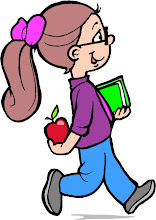We are continuing to read Story Train Monday through Thursday, about four pages each day. One day K. complained, "I have to read all that!" But when she got to the stopping point she didn't want to stop. She said, "But, I want to find out what happens."
Comprehension Skills: Drawing Conclusions, Reading Corner:
I used the questions on pages 72 and 73 to diagnose her skill level. We do need to work on this skill.
I read a variety of fables to K. and let her guess the moral or conclusion. (pg 73, Skill #1)
Cause Clauses -- There were about six sentences, cut in two pieces for K. to match up. For instance: The clouds were so dark | because it was raining. (pg 73, Learning #1)
- I picked a story K. had not read before and read most of it to her, then stopped and asked her what she thought would happen. (pg 73, Skill #2)
- I picked up the book Yummy Riddles by Marilyn Helmer from the library. At the top of each page is the question. Then there is an illustration of the riddle and the answer at the bottom of the page. The illustration gave K. and idea of the answer, but still made her think. I kept a sheet of paper across the bottom of the book to hide the answers. This book was a lot of fun to read. We laughed a lot. (pg 73, Learning #2)
- "What doesn't belong?" -- we took turns writing down four things, then letting the other person cross out the item that didn't belong. Example: bike, car, dress, truck. (pg 73, Skill #3)
- Analogies -- there is a list in the book that we used. K. caught on really quickly. I'm not sure we had done this before. (pg 73, Learning #3)
- I read a story to K. about a boy that wanted to go hunting with his father, but was too young. Then he wanted to go to town with his mother, but had to stay home and watch his sisters. One of his sisters got hurt and he knew how to help her and when his mother got home she was so glad that he had done such a good job taking care of his sisters. I stopped four times while reading the story to ask K. how the boy was feeling then. (pg 73, Skill #4)
- What would happen if? -- talk about what would happen if it never rained, or if we didn't have shoes, or if no one had names, or .... (pg 73, Learning #4)
- Don't Forget Me -- one person lists three things that go together (hand, foot, leg) and the other player says a fourth thing that goes with them (arm). This is a good game for in the car. (pg 74, Learning #5)
- How Do You Know? -- this involves reading a very short story and asking questions where your child has to see the relationships and draw conclusions. (pg 74, Learning #6)
- Why Words -- I had picked out a story in Finding New Neighbors and underlined some sentences or parts of sentences. As I read the story to K., I asked her why or how -- what in the story supported the statement? (pg 74, Learning #7)
From Games for Reading:
